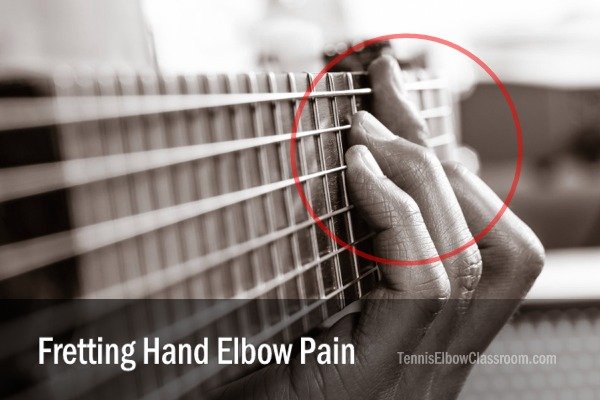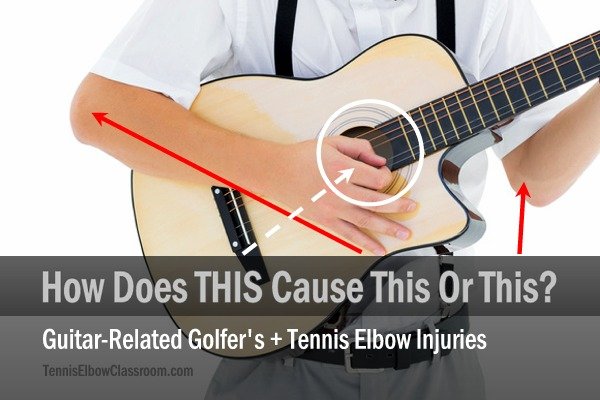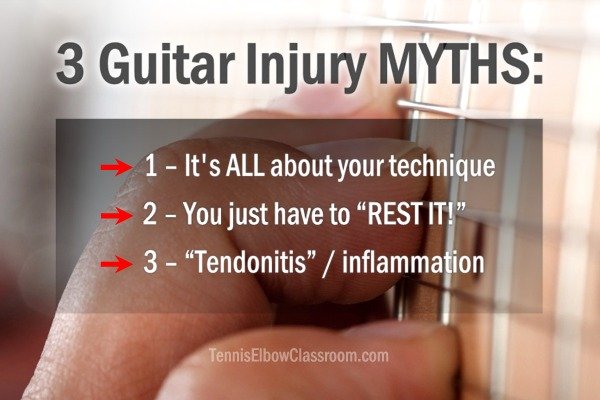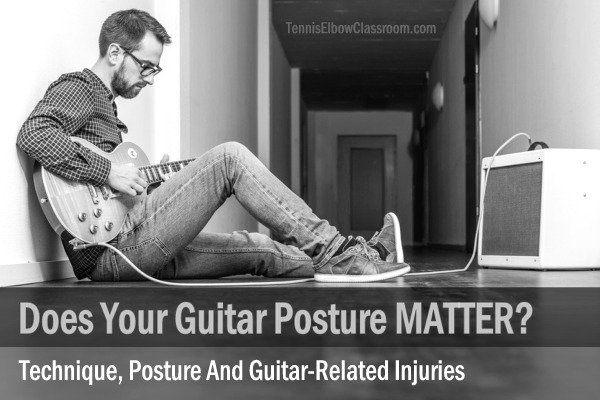Can You Get Tennis Elbow, “Guitar Tendonitis” Or Golfer’s Elbow From Playing The Guitar? (Or Any Other Stringed Instrument?)
Yes, whether you call it Guitar Elbow or, more clinically, Tennis Elbow or Golfer’s Elbow, you can all too easily develop one of these painful injuries from playing guitar or any other stringed instrument.
(These kinds of injuries are actually notorious among stringed instrument players – including both professional and amateur / hobbyist players.)
- Tennis Elbow (which is at the “outer” elbow – AKA, ‘Lateral Epicondylitis’) is unfortunately one of the most common Guitar-Related Injuries.
- Golfer’s Elbow (which is on the “inside” of the elbow– AKA, ‘Medial Epicondylitis’) is also fairly common among guitar players – and other string musicians
But the key thing to keep in mind with these kinds of injuries, often referred to as Repetitive Strain Injuries1-RSIs is that they typically happen gradually, from the cumulative effects of stress and strain.
They are ‘chronic’ injuries that often take many weeks – but more likely months – or even years to build up and to begin causing pain. (Unlike ‘acute’ injuries, which occur suddenly and forcefully.)
This is what makes these injuries so damn insidious! They sneak up on you!
At first, you tend to just dismiss and ignore the initial, relatively minor symptoms of these things – You take a break for awhile… You ice it up, you wrap it up and you pop down a few anti-inflammatories…
But it just doesn’t seem to resolve and keeps flaring up on you – And as the pain intensifies and gets more persistent it starts keeping you from playing and perhaps even from sleeping properly!
You start getting desperate and throwing more things at it: Braces and bands, lotions and creams silly supplements? – Even Cortisone Shots – If you seek medical attention.
Eventually, you realize you’re stuck – In what I call The Tennis Elbow Triple Trap!
Fortunately, just by arriving here at this site, you’re one step closer to escaping The Trap, though!
Does Guitar Elbow / Tennis Elbow Occur On The Strumming Hand Or The Fretting Hand Side?

Tennis Elbow very often occurs in the guitar fretting hand
Guitar players seem to develop Tennis Elbow (OR Golfer’s Elbow) in their fretting hands a lot more often than they experience these injuries in their strumming hands and elbows.
Obviously, there are a lot of fine, repetitive motions and finger positions that involve the finger muscles and tendons when it comes to playing various chords.
Just the same, it’s not exactly rare for guitar players to develop Tennis Elbow (OR Golfer’s Elbow) on their strumming-hand side, either! (Not to mention wrist and shoulder problems.)

Tennis Elbow occurs in the guitar strumming hand, too
If the pain/injury primarily involves your Wrist or Finger Extensor Muscles and their tendon ‘origins’ at your lateral elbow, (the “back side” of the wrist/forearm and “outer” elbow) it’s probably Tennis Elbow.
If the pain/injury primarily involves your Wrist or Finger Flexor Muscles and their tendon ‘origins’ at your inner elbow, (the palm side of the wrist and inner forearm and elbow) it’s likely Golfer’s Elbow.
(And you can also develop wrist and finger Tendinosis of these same muscle groups, as well as thumb tendon issues, like Dequervain’s Tenosynovitis and the frightening Carpal Tunnel Syndrome.)
Not Sure Whether You Have Tennis Or Golfer’s Elbow?
Get your free ‘Tennis Elbow 101’ video course – If you’re not sure which of these injuries you have (perhaps neither) and don’t know very much about them, then take my free video course, Tennis Elbow 101…
I’ll show you the simple tests you can do to assess and basically “diagnose” yourself, and help you get off on the right track understanding your injury and treating it!
Learn more and get your free Tennis and Golfer’s Elbow course here
How Does Playing The Guitar Cause An Injury?

How guitar playing causes injuries, like Tennis and Golfer’s Elbow
The causal dynamic of these insidious injuries is often misunderstood, over-simplified and/or glossed over in the haste of treating the symptoms. It involves:
- The build up of excessive muscle tension (exacerbated by poor technique / posture)
- The formation of adhesions (stuck areas) between layers of muscle and tendons
- The weakening of certain muscles – Along with compensation patterns
- And when things get bad, the breakdown and degeneration of certain tendons.
The good news is, you can be in terrible pain – (including tendon pain) – from the first three things without necessarily having much if any of the 4th: Tendon damage.
How the heck is that “good news!?” It’s twofold:
- These injuries (RSIs) typically begin to hurt well before any actual damage occurs! – (In other words, you will tend to get “warning signs” as your muscles tighten and there’s too much tension on your tendons – so you usually have time to “catch it” before significant tendon damage starts happening, because it’s the tendon damage that’s The Really Serious Stuff!
- And, even if your injury has progressed to the point of damage, it’s often reversible! – (Remember, it’s a gradual process and not a permanent event, and that process can usually be reversed and the damage it causes can often be healed – Not to say that it’s easy, mind you.)
So, you can reverse the process that’s causing your injury and pain – IF you treat it the right way!…
Hopefully, before it causes you any real, significant damage and before it separates you from the guitar you love to play (or NEED to play because it’s your livelihood!
How do you reverse this dynamic?
By releasing your muscular tension and adhesions, strengthening your weakened muscles and tendons…
And doing everything you can to stimulate healing and regeneration in your tendons if your injury has progressed to the point of damage (which is typically degeneration / Tendinosis.)
All of which takes effort. It’s work. Pills, ice, braces, shots and creams will not do it.
From my perspective, it takes diligent, focused, hands-on therapy to accomplish this.
Yes, you should get professional help (IF you can afford it. It is a bit expensive, to be honest.)
Fortunately, you can learn how to do this kind of therapy yourself!
Here’s my article and video on self-massage techniques
And here’s where you can learn more about my self-help programs if you want to learn the best techniques from me, through video lessons:
The Three Biggest Guitar Elbow Treatment Myths

The three biggest guitar injury myths / misconceptions
A huge pitfall with these injuries is that there is SO much bad advice that encourages you to focus on the wrong issues and to “chase the symptoms!”…
Advice that does not direct you to address the real causes: The muscular tension, adhesions, weaknesses (and eventual tendon damage, if allowed to progress far enough.)
There are so many ways to go wrong in treating these injuries, it’s ridiculous!…
I can’t stress this enough. It’s not like the myths, misconceptions and the misguided treatments based on them are harmless, little errors.
I’m convinced (based on 15+ years specializing in treating these injuries) that the standard treatments often make these injuries worse – Sometimes A LOT worse!
So, keep reading. The first step is to avoid stepping in all the B.S. and making all the same mistakes as everyone else!
MYTH #1. It’s All About Your Technique
The first myth you’re likely to hear is that all you need to do to recover is fix your technique
Yes, it’s true that technique (and posture) matter! (See the resources on technique and posture toward the end of this post.)
Poor guitar technique and bad postural habits WILL increase the amount of muscle “workload” and tension in your body…
And that can obviously contribute to an injury, and certainly increases your risk of injury – BUT…
- Not everyone with poor technique and bad posture will develop an injury – Not EVEN over their entire careers, if they’re professional musicians
- And even those with excellent technique and posture can STILL develop an injury – Even if they don’t play all that much!
Now, it’s also possible that optimizing your guitar technique and posture may be enough to stop the progression of your injury – IF you’re in the early stages of it (and if you’re lucky)…
But it’s unlikely to be enough to truly break the vicious cycle, once you’re really in its stubborn grasp…
Meaning when you’re in the mid-to-latter stages of a Golfer’s or Tennis Elbow injury, because the patterns of muscle tension and adhesion don’t necessarily just go away without direct intervention.
So, the myth is that it’s “ALL about technique and posture” when, in fact, it’s a lot more complicated than that.
We’ll talk more about it later on, because it IS very important, just not the whole ball of wax.
So, if you’ve been diligently working on your technique and posture because of an injury (and have accepted the other myths, to follow) and you’re not getting better, don’t be too hard on yourself…
MYTH #2. You Just Need To “Rest It!”
The second myth you’re likely to hear is the idea that all you need to do to heal and recover is rest.
Don’t fall for that bad advice, however, no matter how “true” it sounds – Not even coming from trusted musician friends, music teachers or medical authorities!
And I’m sure the suggestion that you have to put down your guitar and not play it for weeks or months in order to heal is the last thing you want to hear, anyway!
Now, although it’s true that resting may be enough to alleviate some or all of your pain in the initial phases of an RSI like Tennis Elbow…
Rest alone is unlikely to break the cycle!… And, the minute you pick up your guitar and start strumming again, the vicious cycle of tension and pain often ratchets right back up again!
Because:
- Although the pain may subside when you stop playing your guitar for a while – (especially if you do things to suppress your pain and other symptoms, like ice and take anti-inflammatories)…
- The underlying muscular and tendon problems often don’t just heal and resolve themselves – WHILE you’re “Resting, Hoping and Waiting.”
I call this “Hope-And-Wait” rest or ‘Passive Rest’ – Meaning the kind of rest where you simply stop doing the activity that’s causing your pain and nothing more, and I talk more about why it’s the wrong treatment approach here:
WHY rest is the wrong approach and a misconception.
MYTH #3. It’s Inflamed – “Guitar Tendonitis”
The third (massive) myth you will invariably stumble across is that Tennis Elbow (or Golfer’s Elbow) is a form of Tendonitis.
The idea being that your tendons, which are the “cables” between your muscles and your joints, have become significantly, chronically inflamed.
This is rarely what’s actually happening!
It may seem to you, based on the burning pain you’re likely feeling, that “inflammation” MUST be what’s going on in there… It’s obvious – Right!?
But it’s usually NOT what’s really going on – At least not significantly – and not long-term (chronically.)
The fiery, burning pain symptoms are a big part of the reason for the misconception, though.
And why it’s often so easy to sell you anti-inflammatory pills, Cortisone shots, inflammation-soothing creams – and to sell you on the idea of icing yourself repeatedly.
All of which may reduce and relieve your symptoms temporarily (whether they’re caused by inflammation or not!)…
But, NONE of which will actually help you heal!
Because even if there is some inflammation going on in your tendons – What they won’t tell you is that:
Inflammation is a natural, normal part of your healing process.
What really happens to your tendons in Tennis Elbow, Golfer’s Elbow and several of these other injury processes, is that your healing process essentially fails.
Not to say that tendons NEVER get inflamed – OR that there’s no such THING as “Tendonitis”
It’s just that what often ends up happening is a slow process of stagnation and degeneration that gradually weakens the tendons.
(This is caused and fed by that insidious, complex pattern we talked about earlier that involves muscle tension, weakness and often a great deal of muscular adhesion – and even scar tissue sometimes.)
Whatever inflammation may or may not be there is not the problem!
The problem is that healing and regeneration fails to keep up with the stress load on the tendon and it breaks down.
This is not an easy thing to grasp – I know!
Medical researchers don’t entirely understand why this degeneration process happens, either! (although they are very good at describing and classifying what they see happening to the tendons they study under their microscopes)
The important thing to understand – Immediately or as soon as possible after you start having these symptoms…
Is that the answer has NOTHING whatsoever to do with “reducing, suppressing or managing” inflammation or any of the other symptoms.
The answer is to ALLOW any inflammation that’s there because it’s part of the healing process.
And to MOBILIZE the tissues involved – and break that vicious cycle of tension, adhesion, stagnation and degeneration…
NOT to immobilize those muscles and tendons with braces and passive rest.
I understand these principles may sound radical to you! – Especially considering how they contradict the “common medical wisdom” so here’s where you can learn more:
- My article on the principles of treatment: Tennis Elbow Treatment Principles
- And on the principles of exercise: Tennis Elbow Exercise Principles
I’m confident those articles will help put you on the right path, as well as all my treatment-specific articles on:
- Why HEAT – NOT ice is the right way to treat Tennis Elbow
- Why braces are more likely to SLOW your healing process than help it
- Why Cortisone Shots are the absolute WORST mistake you can make!
As you’ll see, much of this site is dedicated to helping you avoid the myths and misconceptions about Golfer’s, Tennis and “Guitar” Elbow – And the mistakes you can make BASED on those myths.
As well as answering many basic questions, like “What exercises should I avoid when I have Tennis Elbow” and so forth.
But if you’re at the point where you need more than just helpful info, and you need an actual self-help program – Then I have those for you in the members area. Here’s where you can learn more:
Learn To Treat And Heal Your Own Tennis Elbow Or Golfer’s Elbow At Home With This Video Program
You’ll get instant access to a complete VIDEO program designed by a professional therapist to help you take charge and break your vicious cycle of pain and frustration!…I’ll be your personal tutor guiding you through step-by-step video lessons, where you’ll get the therapy techniques, key stretches and essential exercises you need to treat and recover from your injury at home. (Without any special equipment.)
Just watch the videos, follow along and start putting an end to your elbow pain today, whether you have Golfer’s or Tennis Elbow from playing your guitar – or other stringed instrument or ANY instrument, for that matter!)
Tennis Elbow sufferers: Learn more about the Tennis Elbow program here
Golfer’s Elbow sufferers: Learn more about the Golfer’s Elbow program here
NOW, we come to the issue of guitar technique, posture and ergonomics, AKA “Guitar Hygiene”
The Importance Of Proper Technique And Posture

The importance of proper guitar technique and posture
Yes! Technique and posture are very important when it comes to reducing the stress load on your muscles and tendons when you have a Guitar Elbow injury.
And it can be key in preventing recurrences, once you’ve made a recovery.
(After all, poor posture and technique are obvious risk factors for developing an RSI.)
So, do optimize your fretting and strumming technique and your posture!
But be sure to treat your muscles and tendons properly, too!
And not just up until you recover – But for maintenance going forward (Ideally, including some core and upper body strengthening and conditioning.)
Here are some resources on guitar technique and posture:
Guitar Posture / Ergonomics
Here’s a video lesson by ‘Justin Guitar’ on posture and finger placement including discussion of:
- Classical vs Rock posture,
- Strap placement and standing up,
- Thumb placement, and more…
Guitar Lesson Video: Body Posture and Finger Placement
Here is JustinGuitar’s YouTube Channel
And his article on: Body Posture & Finger Placement
‘Good Practice Hygiene’ by Tom Hess, discusses guitar injury causes, prevention and treatment, including discussion of:
The common causes of pain from playing guitar and what to do about them.
- Improper posture
- Applying too much pressure
- Not warming up properly, and more…
Principles of Good Practice Hygiene
‘The 7 Top Guitar Posture Mistakes And How To Avoid Them’ an article with video, by Liberty Park Music, covers:
- Sitting posture
- Standing posture
- How to hold the guitar
- Shoulder tension, and more…
Avoiding Guitar Posture Mistakes
In ‘A Guide to Good Guitar Playing Posture’ guitar instructor David Isaacs states that:
“When a player has mastered their game, we say they make it look effortless.”
“You can start to develop this relaxed confidence in your own playing by becoming more aware of your posture.”
A Guide to Good Guitar Playing Posture – Jam Play
Fret Hand Technique And Common Mistakes
‘6 Mistakes That You Probably Make When Playing Guitar’ by Florian Lettner of Fretello, offers 6 valuable tips to improve your fretting covering correct and incorrect fret hand technique.
‘Fretting Hand Tips’ by ‘Fret Me Up’ covers fretting hand positioning tips in a quick lesson with plenty of images:
Fretting Hand Positioning Tips
“Repetitive strain injury (RSI) and associative trauma orders are umbrella terms used to refer to several discrete conditions that can be associated with repetitive tasks, forceful exertions, vibrations, mechanical compression, or sustained/awkward positions… Examples include edema, Tendinosis (or less often Tendinitis), Carpal Tunnel Syndrome, Cubital Tunnel Syndrome, De Quervain syndrome, thoracic outlet syndrome… golfer’s elbow (medial epicondylitis), tennis elbow (lateral epicondylitis), trigger finger… etc.”








Hi Allen,
Really appreciate the website
I have enjoyed playing guitar for over 10 years, lift weights, and work with many tools in my occupation of metal fabrication. (drills, hammers and such).
Since the beginning of this year i have experienced a range of painful symptoms in the elbow (inside of) and wrist as well as occasional tingling/ numbness in the fingers.
I had a EMG done and was diagnosed with carpal and cubital tunnel in the left arm. ( and i suspect the right is not far
behind) I have done physical therapy, and are making lifestyle changes. Overall i am doing “better”, but not to where i was before. Its one day at a time.
I have read through a number of your articles and i know you primarily focus on tennis/ golfers elbow, but i am
very curious in how the info relates to other RSI. ( like not using NSAIDs, exercises to do or avoid, ect.)
Can the programs you offer be used in the treatment/ prevention of carpal and cubital tunnel? other RSIs?
Thanks, Joe
Hi, I haven’t managed to get through the complete article yet but I will do believe me. I just thought I would scroll down quickly and say that I’m enjoying it so far and to maybe ask your opinion. I have just gotten over so called tennis elbow in my right arm which had a 9 x 3 mm tear in the tendon. now I have one in my left arm which is 4 x 2 x 3. I’ve had this for about four months now, I am back on the guitar but it is a little bit sore today after our first 4 song rehearsal. Would your advice be to give it the week until the next one and see how it feels and go do it again? I have at least gotten down to the part of your article where immobilisation seems to be the worst thing to do which I already know. I do have a background in weights and various other training etc. I do get pain up my tricep a little bit too with this one. Since I can’t get much sense out of my doctor about this I thought I would hit you up. I think it’s definitely on the mend but I don’t want to make it worse basically. Thanks for your time
Sorry I didn’t get back to you in a reasonable time, Deon. I’m not always the best with replying to comments. (I do have a better record of responding faster to help requests in the Members Forum, though – Usually withing a day or two.
And I feel I do have to prioritize it that way, so if you are a member (or have become once since posting this) be sure to post questions in the forum – I can’t keep track of who is who any other way and it can obviously take me weeks to get around to blog comments here on the public part of the site.)
Hi Deon, how long did it take you to get over your 3 x 9mm tear? I have a similar size tear. Thanks.
I have index finger “trigger” syndrome on my guitar plucking hand. That finger wants to curl into the palm when I use the middle and ring fingers to play the strings. Occasionally, I can feel the tendon “jump” on the top of my hand (not sure which tendon is “jumping”). I can alternate notes easily if I use the A finger with M finger–no tension. But if I try alternating the M finger with the I finger then the tension increases to the point where the I finger wants to curl inward and not return to its original position. I have recently changed the positioning of my plucking hand so the hand falls naturally from the wrist joint. Hopefully this will help me play with all of my fingers moving with out tension. This is the position taught by Andreas Segovia and many of his followers including John Williams and Chris Parkening.
I would like to hear your comments about the involuntary curling of my plucking index finger when playing the string notes.
Other than heat, I am missing what to do. Thanks for the myths and causes, but what to do? Corrected posture and technique already, thanks.
Does you program work for tendonitis related to playing the guitar?
I have some pain in the wrist from practicing the guitar (but no pain in the elbow) and it
compromises my progress.
It seems that your program is more for tennis. Just wondering.
Yes, as long as the tendon problem is in your fingers, thumb, wrist, forearm and/or elbows – and even your upper arms / bicep/triceps – or any combination thereof. I have modules that help you self treat all those areas. (The thumb module is my latest addition and I’m very proud of it. Nearly every muscle and tendon of the thumb is covered in that lesson.)
I don’t have a program module for the shoulder / Rotator Cuff yet, however. Working on that.
Excellent. Thank you so much for your reply.
I’ve been playing multiple styles of music on various instruments for 40 yrs. This is a nightmare for me. Music is how I think, it’s how I process my life experience, you have given me hope. Thank you.
You are very welcome, Stirling!